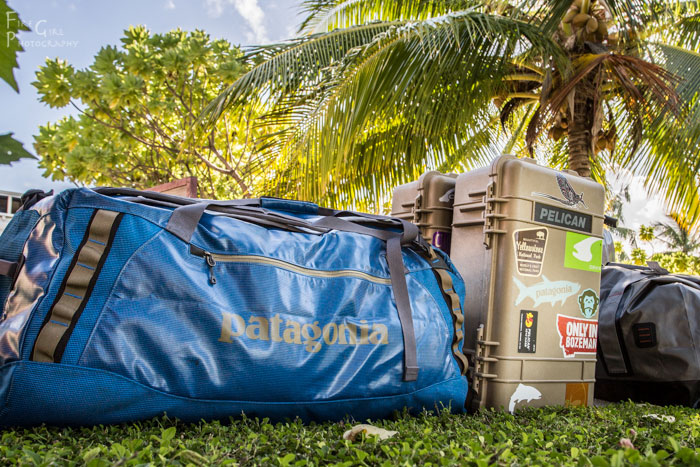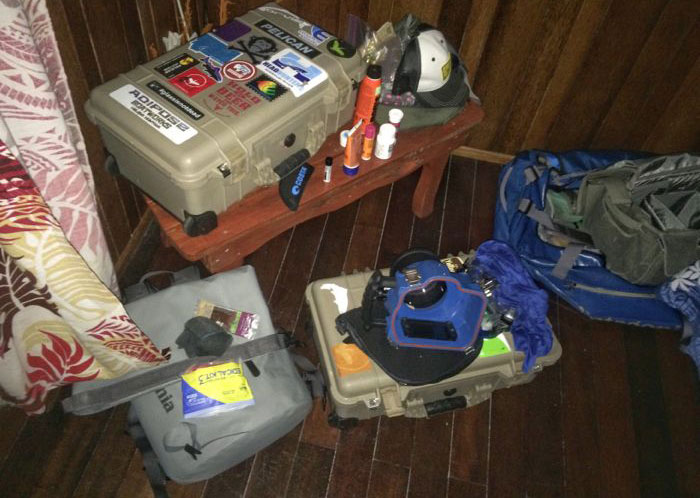
This past few weeks I’ve had several emails from folks asking for a run-down on the gear I pack for fly-fishing assignments. While the kit varies per assignment and location—Russia is going to be different than French Polynesia—here’s a look at the kit I brought along on a recent project with Costa Sunglasses and the IndiFly Foundation on the remote South Pacific atoll of Anaa.
This was an exploratory trip, documenting a location that has been very minimally fished. The nature of the assignment meant I had to prepare for everything from governmental meetings on Tahiti, to food photography, to underwater fish shots. Here’s how the packing list broke down:
Bag 1: Duffel
The duffel is the workhorse. Like a true back hole, it swallows up my snorkeling kit, tripod, food supplies, pack of clothing, toiletries, first aid kit (complete with suture kit and basic travel meds), water filtration bottle, waterproof roll-top backpack, flip-flops, and flats booties. I always make a point to leave a little extra space in the duffel on the way to location—things become unpacked and untidy on the road, and it’s nice to have room for those little things that tend to find their way back home with me.
Bag 2: Pelican I
There’s a reason most of my military friends tend to favor Pelican cases—they’re damn near bombproof. This roller is checked, and holds the underwater photography equipment (AquaTech), solar hub (GoalZero), lighting equipment, and other assorted photographic odds-and-ends. It went on the boat every day, serving as a waterproof, protective home for whichever camera I wasn’t shooting at the moment.
Bag 3: Pelican II
This Pelican lives with me… I once slept curled around this thing on the floor of Reagan International in D.C., and it has its own special little place next to the couch at home. Camera bodies, lenses, cleaning gear, and the GoPro live in here. For trips like this (sandy, hot, sticky climates) an extra desiccant pack—or two—is essential. At night, all tech gear is sealed up tight with the desiccants in the Pelican cases.
Bag 4: ThinkTank Photo Retrospective
When ThinkTank Photo sent me this shoulder bag to review years ago, little did I know it would become my favorite working bag. The canvas-like exterior looks beat up and a bit old fashioned, two big pluses when I’m working in an area where a fancy camera bag would draw unwanted attention. It’s big enough to hold a camera body and several lenses, but for this trip it did doing double duty as a laptop bag and home to assorted books / snacks / chapstick. Hidden pockets and a built-in rain cover make me happy, and I’ve found it slips nicely on the top of the Pelican for airport sprints.
On the flats each day, I carried a Patagonia Roll-top backpack, one Pelican (it stayed in the boat), and a mesh bag with snorkeling gear. Photographers are notorious for hopping boat-to-boat, and it’s nice to be able to be easily mobile. Pretty much every day on the Polynesia trip I was changing boats midday so I could photograph a different location and new anglers, and the ability to just grab-and-go was helpful.
And that’s it. The goal is to cover all the bases in case something goes wrong, which it usually does, without having to schlep around tons of gear. Ideally I’m a two-bag girl, but sometimes circumstances demand a bit more equipment. And it is always rather nice to be packing for a tropical assignment and not a snowy one… flats pants and swimsuits pack down far smaller than jeans and fleece.
That said, I’m just back from a shoot in South Carolina, and heading up to Alaska’s Bristol Bay Lodge next month. While the kit will have some variance not too much will change. It’s all about the systems.


